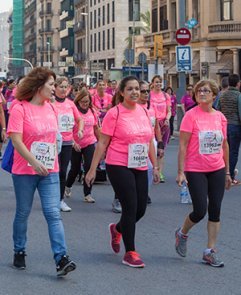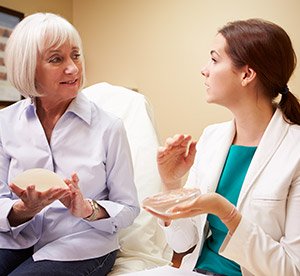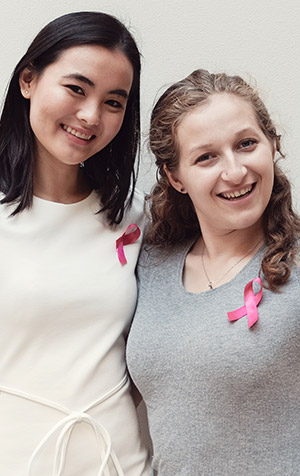Breast Cancer Awareness Month—widely recognized by the pink ribbon as its symbol—is observed every October to increase awareness and to raise funds for research to prevent, treat, and cure the disease. This yearly campaign aims to educate women about the importance of early screening, testing, and more. Additionally, it offers information and support to those affected by breast cancer.
The American Cancer Society estimates that 266,120 new cases of invasive and 63,960 new cases of noninvasive breast cancer will be diagnosed in women during 2018.
Who Gets Breast Cancer?

Breast cancer is the most common cancer among women in the United States and the second most common cause of cancer death in women, claiming thousands of lives worldwide.
- One in eight women in the United States will be diagnosed with breast cancer in her lifetime.
- On average, one woman is diagnosed with breast cancer every 2 minutes and one woman dies of breast cancer every 13 minutes.
- Although breast cancer in men is rare, an estimated 2,470 men will be diagnosed with and approximately 460 will die of breast cancer each year.
- Over 3.3 million breast cancer survivors are alive in the United States today.
What Are the Risk Factors for Breast Cancer?
Women with certain risk factors are more likely than others to develop breast cancer. Although some risks may be avoided or reduced, such as smoking, others, like genetic disposition, cannot.
Risk factors include:
- Age (over 65)
- Family history
- Personal history of previous breast, endometrial, ovarian, or colon cancer
- Type 2 diabetes
- Never having been pregnant
- First child after age 30
- Obesity
- Alcohol and drug consumption
- Long-term, heavy smoking
- Lack of exercise
Are There Lifestyle Choices to Reduce the Risk?

Yes, these factors contribute to a healthy lifestyle and may aid in preventing cancer:
- Eating a diet consisting of mostly fruits and vegetables, whole grains, and legumes
- Engaging in moderate physical activity for at least 2.5 hours or vigorous exercise for 75 minutes weekly
- Participating in strength-training exercises at least two days per week
- Limiting alcohol consumption to no more than one drink per day
- Quitting smoking or other types of tobacco use
- Attending annual cancer screenings
Breast cancer is the most common cancer among women in the United States and the second most common cause of cancer death in women, claiming thousands of lives worldwide.
How Can Nurses and Healthcare Providers Educate Patients about Breast Cancer?
Nurses and other healthcare providers frequently care for women with breast cancer in the acute and chronic stages of the disease.
Diagnosis and treatment for breast cancer varies based on many factors, including type, stage, and other individual differences. Women may be presented with various treatment options and need expert guidance to assist in decision making and weighing short- and long-term effects of each treatment choice.
Following the shock of a breast cancer diagnosis, patients may feel overwhelmed. At this time, nurses and other healthcare providers can assist by calmly answering any questions and offering more details about the various treatment options. Encouraging patients to take notes or have a trusted friend or relative with them during the appointment can help.
A nurse or healthcare professional can recommend further counseling from an independent counselor or specialized oncology social worker such as those from Cancer Care. Oncology social workers are licensed professionals specifically trained to provide individual counseling, lead support groups, locate services that help with home care or transportation, and guide people through the process of applying for Social Security disability or other forms of assistance.
What about Breast Reconstruction?

For most, treatment does not end with the initial surgery, radiation, and/or chemotherapy but may also include long-term surgeries for reconstruction as well as endocrine therapy for a period of 5 to 10 years to prevent recurrence.
Frequently asked questions about breast reconstruction include:
- Am I a candidate for breast reconstruction?
- What type of reconstruction is the best for me and why?
- Will my new breast look and feel different from my other breast?
- Can I see pictures of reconstructive surgeries that show the final results?
- What are the risks and possible complications?
- When is the best time to have this done?
- How long will I be in the hospital? How long is total recovery time?
- Will I need help at home after surgery?
- When will I be able to exercise again? Are there any restrictions?
- What is the average cost? Does insurance usually cover this?
What Is the Survival Rate?

Breast cancer is a common malignancy among women, representing 4 in 10 female cancer survivors in the United States. Long-term survival is common after breast cancer treatment, with a 5-year survival rate of almost 90%.
As women live longer with breast cancer and the associated long-term treatments, care has shifted to a chronic care model. Women with a history of breast cancer will benefit from the initiation of standards and expectations to provide patients with an individualized survivor care plan to assist them in being as informed as possible about their future.
Survivorship for women with a history of breast cancer may include monitoring and surveillance of short- and long-term effects of treatment as well as screening for other secondary cancers. Women who are actively involved in their care, with a focus on wellness goals—including nutrition, mind-body strategies, and exercise—may experience a better quality of life and have a decreased chance of cancer recurrence.
To Learn More…
To raise awareness and educate nurses, case managers, and occupational therapists and assistants on breast cancer, Wild Iris Medical Education is offering a $10 discount on its 8-contact hour Breast Cancer CEU course during Breast Cancer Awareness Month (through 10/31/2018). ANCC-accredited and AOTA-approved provider for online continuing education credit.
Sign up for our newsletter email list and like us on Facebook and Instagram to be among the first to know about all our special discounts and offers!
About Wild Iris Medical Education:
Wild Iris Medical Education, Inc., is a privately held, woman-owned company providing online healthcare continuing education. In 1998, we began offering online ANCC-accredited nursing continuing education courses and since then have expanded to provide CEUs for occupational therapists, physical therapists, paramedics, EMTs, and other healthcare professionals.
Accredited and Approved Nationwide.
High-quality CEU Courses since 1998.

Join Our More Than 750,000 Satisfied Customers Now!
High-quality, accredited, evidenced-based continuing education courses in an easy-to-use format designed for learning, from Wild Iris Medical Education. We’ve been providing online CE since 1998.



